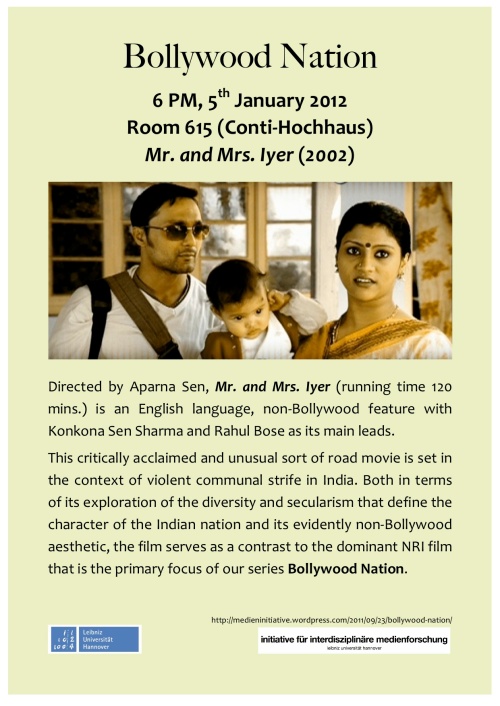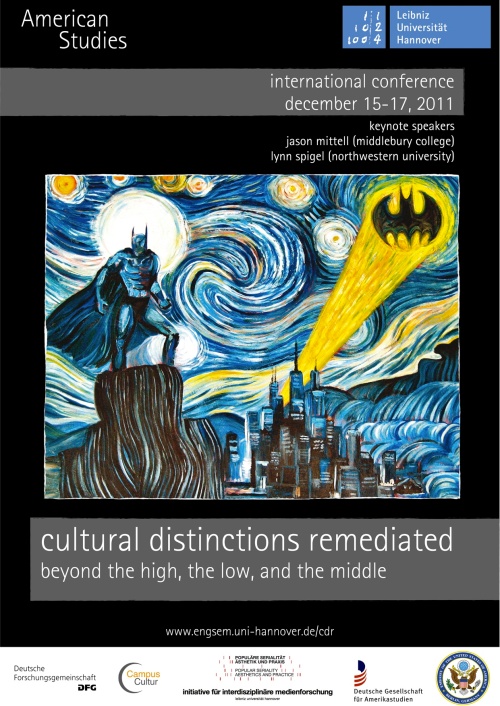On Thursday, January 5, 2012, we will be screening the fourth film in our Bollywood Nation series: Mr. and Mrs. Iyer. As usual, the screening will begin at 6:00 PM (room 615 in the Conti-Hochhaus). As indicated on our poster above, the 2002 film serves in several respects as a contrast to the other films in our series. More information about the film can be found on imdb.com.
Month: December 2011
Roland Faelske-Preis für Comic und Animationsfilm 2012
[scribd id=76711267 key=key-24ixcjn6dyg23b78qb4p mode=list]
Ausschreibung: Roland Faelske-Preis für Comic und Animationsfilm 2012
Die Universität Hamburg und die Roland Faelske-Stiftung loben im Jahr 2012 zum zweiten Mal den Roland Faelske-Preis für Comic und Animationsfilm aus. Ausgezeihnet werden Studierende und Promovenden für herausragende Arbeiten aus dem Themenbereich ‘Comic’ oder ‘Animationsfilm’.
Der Preis wird in zwei Kategorien verliehen:
Für die beste Magister-, Diplom-, Master- oder Bachelor-Abschlussarbeit, dotiert mit 1.000 Euro
und für die beste Dissertation, dotiert mit 3.000 Euro.
Annahmeschluss für empfohlene Arbeiten ist der 30. Juni 2012.
Die Zulassungsbedingungen entnehmen Sie bitte der ausführlichen Ausschreibung sowie der ‘Richtlinie für die Verleihung des Roland Faelske-Preises’.
Auskünfte erteilt Herr Prof. Dr. Markus Kuhn.
markus.kuhn@uni-hamburg.de
CFP: Comics and Politics
Comics and Politics
7th Annual Conference of the Gesellschaft für Comicforschung (Society for Comics Studies)
at the Institute for Media Culture Studies, University of Freiburg
September 27-29, 2012
comfor2012.comicgesellschaft.de
We invite abstracts for each of the following three parts of the conference: Talks on the main conference topic, Comics and Politics (1); reports on ongoing research projects for any aspect of comics studies for open workshop sessions (2); as well as posters on any topic concerning comics studies (3).
1. Call for Papers on Comics and Politics
Comics interact with politics and the political in several obvious ways: As a format of artistic expression, as a sometimes popular, alternative or marginalized genre, and not least as an element of new media, comics feature specific political dimensions that are not always sufficiently covered by concepts developed for the description of politics in other art forms. While several studies have dealt with particular instances, the special role of comics as archive, player, playing field, and constituent of political processes has rarely been examined under a common perspective.
The 7th Annual Conference of the Gesellschaft für Comicforschung thus invites contributions from different disciplines and starting points that deal with any of the many constellations of comics and politics. Some of these views might, for instance, connect to recent thoughts on an ‘ethical turn’ in cultural studies, or equally to contemporary questions and theories from pictorial studies.
Contributions might address any of the following three broad subjects, among others:
I. Comics Activism: Criticism and Propaganda
Political elements in comics are most conspicuous where they are dealt with topically and explicitly: In depictions, evaluations, negotiations and interventions of political issues. Such comics come in many different forms, from propaganda with a clear political, religious, or cultural agenda, through satirical, subversive, and socially critical work, up to and including alternative media and grey publications. Along with other fictional or documentary comics on contemporary or historical political issues, they also add to an archive of political topics and discourses. Some prominent examples here might connect to Postcolonial or Gender Studies, which have sometimes been somewhat neglected in existing comics studies.
Contributions to this area might, for instance, deal with contexts of publication, habits of reading, dimensions of social effect, as well as topical content and delivery of political concepts in comics. Some objects for research might include cultural treatments of political processes (such as comics ‘about’ the Third Reich, the Cold War, 9/11, etc.); as well as comics that are actively engaged in political debate (such as comics ‘in favour of’ Christian fundamentalism, alternative energy sources, equal rights movements, etc.); but also and not least comics that are foremost conceived and produced as parts of official or alternative political discourses (such as comics ‘in’ politics: the report of the 9/11-commission, military informational and instructional material, etc.).
II. Comics under Control: Censorship and Comic Codes
From a different angle, comics appear as objects of political processes: Where they have been regarded dominantly as children’s and youth literature, they have variously come under the gaze of different concepts of education and socialization, and have been discussed as paradigmatic ‘new media’ – both in apocalyptic warnings of destructive media or as positive vehicles of integration. In other contexts, comics have been described as subversive and alternative forms of communication: Underground Comix and other formats often deliberately play with a performative self-marginalization, employing ostentative obscenity, phantasmagorical depictions of violence, pornography and other echoes of content excluded in controlled media.
Contributions to this area might, for instance, deal with explicit calls for censorship (such as those connected to Wertham’s Seduction of the Inncocent or the Comics Code Authority) through circumstantial pressure on forms and contents (such as modified imagery in recent Barks- and Hergé-publications) up to texts that offer self-reflective commentary on their own limits (perhaps most prominently in Maus’ differentiated self-commentary on the limits and discomforts of its animal allegories). In all of these, political control of media can also be read as a political view of media: In these discourses, comics are first described as harmful, deviant, dangerous, or as productive, useful, educational, in order to justify calls for their restriction or propagation. Can Wertham’s condemnation of comics also count as one of the first detailed, if controversial, analyses of comic books and panel structures?
III. Comics as a Political Art Form: Aesthetics and Ideology
Beyond the explicit treatment of the political in comics, and the explicit treatment of comics in political discourse, many further questions concern the political dimension of specific aesthetics, imageries, and media dispositives in comics. Connecting to models of cultural criticism (from Benjamin and Adorno through to Didi-Huberman, Rancière, or Badiou, or particular theories of pictorial ideology by the likes of Oudart or Heath, and many more), contributions to this area might deal, for instance, with basic constituents of comics and their mimetic conventions, structural effects, processes of narrativization and fictionalization, body imaginations and genre traditions. The very division of the sensual realm into writing and image can no less avoid political relevance than the many issues surrounding a just and justifiable depiction of realities and intentions.
This opens up questions about the formal semantics of the art form, some of which are again dealt with explicitly in comics. Are comics systematically, or are particular comics especially, politically resistant, by the very means of their artistic practice? Or does their connection to mass production and mass media ground them in politically affirmative mainstream cultures? Which concepts might be employed to describe such a basic political dimension of comic book aesthetics?
2. Call for Papers for the Open Workshop
Beyond the discussion of each year’s special topic, the German Society for Comics Studies aims to further co-operation and dialogue in all areas of comics research. The 7th Annual Conference will therefore re-introduce an open workshop format that allows researchers to present and gather feedback on on-going projects within comics studies in all stages of development, and without any thematic restrictions – not limited to comics and politics. The invitation stands for colleagues in all phases of academic careers to discuss any projects on which they are currently working, be it as BA, MA or PhD candidates, established institutional researchers, or free scholars.
3. Call for Papers for the Poster Section
The third part of the conference will, for the first time, present a poster section. Ongoing as well as concluded research projects on all topics – not limited to comics and politics – can be presented on posters. Posters will be on exhibition for the whole time of the conference, and a special poster session will give the authors an opportunity to explain and discuss their work in detail.
We invite short abstracts (1) for 30-minute talks on any topic concerning comics and politics, or (2) for 20-minute presentations in the Open Workshop, or (3) for contributions to the Poster Section.
Please clearly mark your abstract as (1), (2) or (3), and include a short biography and bibliography. Abstracts are welcome by email, as pdf or rtf files. Deadline: February 1, 2012.
For further information, please see comfor2012.comicgesellschaft.de .
Contact:
Dr. Stephan Packard Juniorprofessor für Medienkulturwissenschaft Albert-Ludwigs-Universität Freiburg Werthmannstraße 16 79098 Freiburg Tel. +49-761-203-97842 stephan.packard@medienkultur.uni-freiburg.deNiklas Luhmann’s Theory of Memes
Over at her blog Judgmental Observer, Amanda Ann Klein has a great post up about Internet memes, their workings, and their humor. In addition to the central themes of “cruelty” and “self-loathing” that she sees at work, Klein points to two formal aspects of successful memes: “recognizability” and “repetition.”
This reminded me of Niklas Luhmann’s theory of media, itself a sort of “remediation” of psychologist Fritz Heider’s distinction of medium vs. thing, which comes down to a distinction between a “loose coupling” and a “tight coupling” of elements of a given sort (see Heider’s Ding und Medium). For Luhmann, mediality consists in the relation between a loosely coupled “medial substrate” and the tightly coupled “forms” that it is capable of assuming — or, in other words, in the “operative deployment of the difference of medial substrate and form” (Luhmann, Die Gesellschaft der Gesellschaft 195; my translation), which is itself relative to an observer or system.
(For more on Luhmann’s theory of media, see Chapter 3 (165-214) of Luhmann, Die Kunst der Gesellschaft (translated as Art as a Social System). See also Chapter 2 (190-412) of Luhmann, Die Gesellschaft der Gesellschaft.)
The connection with Klein’s notions of “recognizability” and “repetition” as formal elements of memification comes when Luhmann, on one occasion, notes that one way to elaborate his distinction of medial substrate and form is “by means of the distinction between redundancy and variety” (Art as a Social System 105). He explains:
The elements that form the medium through their loose coupling—such as letters in a certain kind of writing or words in a text—must be easily recognizable. They carry little information themselves, since the informational content of an artwork must be generated in the course of its formation. The formation of the work creates surprise and assures variety, because there are many ways in which the work can take shape and because, when observed slowly, the work invites the viewer to contemplate alternate possibilities and to experiment with formal variations. (105)
“Variety through repetition” is the formal basis of the Internet meme, as well as being a principle of seriality and a formal description of mediality itself (following Luhmann). As I recently argued for Lady Gaga, Nyan Cat can also be dubbed a “serial media remix”: Nyan Cat is the instantly recognizable, iconically redundant substrate out of which ever new forms are produced; these forms become available, in turn, for sampling, and they serve as the substrate of a higher-order mediality, thus proliferating in a (non-linear) serial explosion.
Long live Nyan Cat: memifier of Internets, proliferator of serial forms, and media remixer extraordinaire! All your substrate are belong to us!!!11!
Bollywood Gaga
[youtube http://www.youtube.com/watch?v=v8dJicEtrGs]
Apart from superheroes, politics, Photoshop, and video games (see yesterday’s post), two other obsessions interests of this blog over the past several months have been Bollywood and Lady Gaga. There are, of course, reasons for all of these things: my interest in superheroes is related to my work on comics, and they’ve been brought together with American politics (and especially #OWS) in ways that highlight the importance of visual and social media at the current moment, while, at the same time, I’ve been teaching a seminar on game studies this semester. Then there’s our still ongoing Bollywood Nation film series (in which three films have been screened so far, all starring Shah Rukh Khan), and I gave a presentation on Gaga last week at our conference on “Cultural Distinctions Remediated.” Strangely, all of these things are starting to come together: here, Shah Rukh Khan interviews Gaga on Indian television, going so far as to raise the prospect of Gaga acting in a Bollywood movie!
Who’s Really Running Things…
How did I miss this? Anyway, now that I’ve discovered this ingenious reworking of the photo taken May 1, 2011, as news of Osama bin Laden’s death came to the White House situation room, I thought I’d put it up here to continue the blog’s occasional focus on the points of contact between Photoshop, superheroes, and politics (and video games: look at their computer screens!).
Techno-Phenomenology and TV
Recently I posted about a paper of mine coming out in the open-access journal Phenomenology & Practice, entitled “Faith in Technology: Televangelism and the Mediation of Immediate Experience.” Now, my article, along with the new issue of P & P, has gone online (the entire contents can be found here), and I hope that you’ll take a look.
Anyway, as I mentioned a couple of weeks ago, I think that the “techno-phenomenological” approach I have taken towards the topic of televangelism may also be adaptable to fictional narrative television, and that it might thus provide a complement to — not a replacement for — more traditional (narratological-formal and industrial-social-contextual) approaches to television studies. This remains to be seen, of course, and I look forward to hearing your comments on the text itself and on the prospects of adapting its methodology to other sorts of projects.
Incidentally, though, since the time of suggesting that such adaptation might be possible, it has occurred to me that I once undertook a very cursory attempt at doing just that: in a very short essay, entitled “Techno-Habitats and Media Habits: Reflections on Contemporary Children’s Television” (originally published in Philament 12), I implicitly assumed a techno-phenomenological approach to young children’s TV shows like Teletubbies, Bob the Builder, or Lunar Jim. That paper, roughly contemporary with my initial work on the televangelism paper, just sketched out some ideas, presenting them in a literally essayistic manner, while the theoretical and methodological underpinnings were not explored. Now, with the publication of the televangelism paper, the methodology in particular has become available for inspection (the deeper theoretical implications, on the other hand, remain buried in the media-philosophical Part Two of my dissertation, Postnaturalism: Frankenstein, Film, and the Anthropotechnical Interface). So please take a look and let me know what you think about the prospects for a techno-phenomenological form of television studies.
Thank You
This is just a quick thank you note to everyone involved with last week’s two overlapping events: the theme week on “Popular Seriality” at In Media Res, and the conference we hosted on “Cultural Distinctions Remediated: Beyond the High, the Low, and the Middle.”
First, thanks to my co-curators at In Media Res: Frank Kelleter, Ruth Mayer, Jason Mittell, Andreas Jahn-Sudmann, and Daniel Stein. Because of them and the external commenters, the theme week — in addition to being a lot of fun — provided lots of food for thought and continuing conversations. Thanks also to Karen Petruska from In Media Res for guiding us through the process of setting up the theme week. And while the theme week is officially over, everything will remain online (here) and open for further comments and discussions. So if you’ve got something to say about the topic of popular seriality, it’s not too late!
Thanks as well to everyone who made the conference “Cultural Distinctions Remediated” such a success: our keynote speakers Jason Mittell (who, in case you missed it, has posted his talk here) and Lynn Spigel; fellow speakers Regina Schober, Bettina Soller, Andreas Jahn-Sudmann, Florian Groß, and Christina Meyer; my co-organizers Ruth Mayer, Vanessa Künnemann, and Florian Groß; and our great assistants Felix Brinker, Svenja Fehlhaber, and Hannah Pardey! Thanks also to our sponsors: the US Embassy in Berlin, the Deutsche Gesellschaft für Amerikaforschung, the Deutsche Forschungsgemeinschaft, Campus Cultur, and the Freundeskreis der Leibniz Universität Hannover. Thanks, finally, to everyone who attended, asked stimulating questions, and helped generate interesting discussions!
Nightmare Before Christmas
[youtube http://www.youtube.com/watch?v=5gUKvmOEGCU]
On Wednesday, December 21, 2011 (6pm, room 609 in the Conti-Hochhaus), the Film & TV Reading Group will meet to discuss Steven Shaviro’s “Contagious Allegories: George Romero,” a chapter from his now classic book The Cinematic Body. In the spirit of the holiday season, though, and in light of the fitting subject matter, we’ve decided to make it into a somewhat more festive event than usual: we’ll start off by screening the first of Romero’s zombie movies, Night of the Living Dead (1968). Glühwein and zombies: it just doesn’t get much more Christmas-y than that!
Cultural Distinctions Remediated
Our conference “Cultural Distinctions Remediated: Beyond the High, the Low, and the Middle” begins today, December 15, 2011. Jason Mittell will start things off this evening (6:00 pm in the Niedersachsensaal at Königsworther Platz 1) with a talk on “The Complexity of Quality: Cultural Hierarchies & Aesthetic Evaluation in Contemporary Television” (see also here for a preview). Tomorrow, there will be six talks divided into two panels (see here for the full program, with links to all individual abstracts). And Lynn Spigel will wrap things up on Saturday morning with her talk on “Designer TV: Television and the Taste for Modernism in Mid-Century America”.





